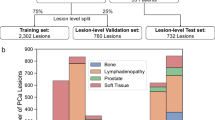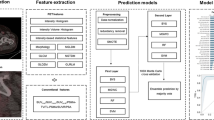Abstract
Purpose
This study proposes a detection support system for primary and metastatic lesions of prostate cancer using \({}_{{}}^{18} {\text{F}}\)-PSMA 1007 positron emission tomography/computed tomography (PET/CT) images with non-image information, including patient metadata and location information of an input slice image.
Methods
A convolutional neural network with condition generators and feature-wise linear modulation (FiLM) layers was employed to allow input of not only PET/CT images but also non-image information, namely, Gleason score, flag of pre- or post-prostatectomy, and normalized z-coordinate of an input slice. We explored the insertion position of the FiLM layers to optimize the conditioning of the network using non-image information.
Results
\({}_{{}}^{18} {\text{F}}\)-PSMA 1007 PET/CT images were collected from 163 patients with prostate cancer and applied to the proposed system in a threefold cross-validation manner to evaluate the performance. The proposed system achieved a Dice score of 0.5732 (per case) and sensitivity of 0.8200 (per lesion), which are 3.87 and 4.16 points higher than the network without non-image information.
Conclusion
This study demonstrated the effectiveness of the use of non-image information, including metadata of the patient and location information of the input slice image, in the detection of prostate cancer from \({}_{{}}^{18} {\text{F}}\)-PSMA 1007 PET/CT images. Improvement in the sensitivity of inactive and small lesions remains a future challenge.








Similar content being viewed by others
References
MaryBeth BC, Isabelle S, Jason AE, Freddie B, Ahmedin J (2020) Recent global patterns in prostate cancer incidence and mortality rates. Eur Urol 77:38–52. https://doi.org/10.1016/j.eururo.2019.08.005
Siegel RL, Miller KD, Goding Sauer A, Fedewa SA, Butterly LF, Anderson JC, Cercek A, Smith RA, Jemal A (2020) Colorectal cancer statistics. CA: Cancer J Clin 70(3):145–164. https://doi.org/10.3322/caac.21601
Mason BR, Eastham JA, Davis BJ, Mynderse LA, Pugh TJ, Lee RJ, Ippolito JE (2019) Current status of MRI and PET in the NCCN guidelines for prostate cancer. J Natl Compr Cancer Netw 17(5):506–513. https://doi.org/10.6004/jnccn.2019.7306
Schmidkonz C, Cordes M, Goetz TI, Prante O, Kuwert T, Ritt P, Uder M, Wullich B, Goebell P, Bäuerle T (2019) 68Ga-PSMA-11 PET/CT derived quantitative volumetric tumor parameters for classification and evaluation of therapeutic response of bone metastases in prostate cancer patients. Ann Nucl Med 33:766–775. https://doi.org/10.1007/s12149-019-01387-0
Seifert R, Herrmann K, Kleesiek J, Schäfers M, Shah V, Xu Z, Chabin G, Grbic S, Spottiswoode B, Rahbar K (2020) Semiautomatically quantified tumor volume using 68Ga-PSMA-11 PET as a biomarker for survival in patients with advanced prostate cancer. J Nucl Med 61(12):1786–1792. https://doi.org/10.2967/jnumed.120.242057
Hofman MS, Lawrentschuk N, Francis RJ, Tang C, Vela I, Thomas P, Rutherford N, Rutherford MJM, Frydenberg M, Shakher R, Wong LM, Taubman K, Lee ST, Hsiao E, Roach P, Nottage M, Kirkwood I, Hayne D, Link E, Marusic P, Matera A, Herschtal A, Iravani A, Hicks RJ, Williams S, Murphy DG, Taneja S (2020) Prostate-specific membrane antigen PET-CT in patients with high-risk prostate cancer before curative-intent surgery or radiotherapy (proPSMA): a prospective, randomised, multicentre study. The Lancet 395(10231):1208–1216. https://doi.org/10.1016/S0140-6736(20)30314-7
Tateishi U (2020) Prostate-specific membrane antigen (PSMA)–ligand positron emission tomography and radioligand therapy (RLT) of prostate cancer. Jpn J Clin Oncol 50(4):349–356. https://doi.org/10.1093/jjco/hyaa004
Awenat S, Piccardo A, Carvoeiras P, Signore G, Giovanella L, Prior JO, Treglia G (2021) Diagnostic role of 18F-PSMA-1007 PET/CT in prostate cancer staging: a systematic review. Diagnostics 11(3):552. https://doi.org/10.3390/diagnostics11030552
Foley RW, Redman SL, Graham RN, Loughborough WW, Little D (2020) Fluorine-18 labelled prostate-specific membrane antigen (PSMA)-1007 positron-emission tomography-computed tomography: normal patterns, pearls, and pitfalls. Clin Radiol 75(12):903–913. https://doi.org/10.1016/j.crad.2020.06.031
Tateishi U, Kimura K, Tsuchiya J, Kano D, Watabe T, Nonomura N, Saito K, Yokoyama K, Yamagiwa K, Adachi T, Kojima Y, Yoshida S, Fujii Y (2023) Phase I/IIa trial of 18F-prostate specific membrane antigen (PSMA) 1007 PET/CT in healthy volunteers and prostate cancer patients. Jpn J Clin Oncol. https://doi.org/10.1093/jjco/hyad166
Watabe T, Uemura M, Soeda F, Naka S, Ujike T, Hatano K, Sasaki H, Kamiya T, Shimosegawa E, Kato H, Cardinale J, Tateishi U, Nonomura N, Giesel FL (2021) High detection rate in 18F-PSMA-1007 PET: Interim results focusing on biochemical recurrence in prostate cancer patients. Ann Nucl Med 35:523–528. https://doi.org/10.1007/s12149-021-01602-x
Zhao Y, Gafita A, Tetteh G, Haupt F, Afshar-Oromieh A, Menze B, Eiber M, Rominger A, Shi K (2019) Deep neural network for automatic characterization of lesions on 68Ga-PSMA-11 PET/CT Images. In: 2019 41st annual international conference of the ieee engineering in medicine and biology society, pp 951–954. https://doi.org/10.1109/EMBC.2019.8857955
Capobianco N, Sibille L, Chantadisai M, Gafita A, Langbein T, Platsch G, Solari EL, Shah V, Spottiswoode B, Eiber M, Weber WA, Navab N, Nekolla SG (2022) Whole-body uptake classification and prostate cancer staging in 68Ga-PSMA-11 PET/CT using dual-tracer learning. Eur J Nucl Med Mol Imaging. https://doi.org/10.1007/s00259-021-05473-2
Mei X, Lee HC, Diao KY, Huang M, Lin B, Liu C, Xie Z, Ma Y, Robson PM, Chung M, Bernheim A, Mani V, Calcagno C, Li K, Li S, Shan H, Lv J, Zhao T, Xia J, Long Q, Steinberger S, Jacobi A, Deyer T, Luksza M, Liu F, Little BP, Fayad ZA, Yang Y (2020) Artificial intelligence–enabled rapid diagnosis of patients with COVID-19. Nat Med 26(8):1224–1228. https://doi.org/10.1038/s41591-020-0931-3
Yap J, Yolland W, Tschandl P (2018) Multimodal skin lesion classification using deep learning. Exp Dermatol 27(11):1261–1267. https://doi.org/10.1111/exd.13777
Perez E, Strub F, De Vries H, Dumoulin V Courville A (2018) Film: visual reasoning with a general conditioning layer. AAAI Confer Artif Intell. https://doi.org/10.1609/aaai.v32i1.11671
Maryam H, Luca C, Éric P (2022) End-to-end brain-driven speech enhancement in multi-talker conditions. IEEE/ACM Trans Audio, Speech, Lang Process 30:1718–1733. https://doi.org/10.1109/TASLP.2022.3169629
Mengwei R, Neel D, James F, Guido G (2021) Segmentation-renormalized deep feature modulation for unpaired image harmonization. IEEE Trans Med Imaging 40(6):1519–1530. https://doi.org/10.1109/TMI.2021.3059726
Qin ZQ, Pan GJ, Xu Z, Wang H, Xu LW, Jia RP (2022) The performance of 18F-PSMA PET/CT in the detection of prostate cancer: a systematic review and meta-analysis. Asian J Androl 24(4):373. https://doi.org/10.4103/aja202162
Nioche C, Orlhac F, Boughdad S, Reuzé S, Goya-Outi J, Robert C, Pellot-Barakat C, Soussan M, Frouin F, and Buvat I (2018) LIFEx: a freeware for radiomic feature calculation in multimodality imaging to accelerate advances in the characterization of tumor heterogeneity. Cancer Res 78(16):4786–4789. https://www.lifexsoft.org/. Accessed 12 May 2023
Fu X, Bi L, Kumar A, Fulham M, Kim J (2021) Multimodal spatial attention module for targeting multimodal PET-CT lung tumor segmentation. IEEE J Biomed Health Inform 25(9):3507–3516. https://doi.org/10.1109/JBHI.2021.3059453
Thie JA (2009) Understanding the standardized uptake value, its methods, and implications for usage. J Nucl Med 45(9):1431–1434
He K, Zhang X, Ren S, Sun J (2015) Delving deep into rectifiers: Surpassing human-level performance on imagenet classification. IEEE Int Confer Comput Vis. https://doi.org/10.1109/ICCV.2015.123
Kingma DP, Ba J (2014) Adam: A method for stochastic optimization. arXiv preprint arXiv:1412.6980
Wang T, Lei Y, Fu Y, Wynne JF, Curran WJ, Liu T, Yang X (2021) A review on medical imaging synthesis using deep learning and its clinical applications. J Appl Clin Med Phys 22:11–36. https://doi.org/10.1002/acm2.13121
Sluis J, Jong J, Schaar J, Noordzij W, van Snick P, Dierckx R, Borra R, Willemsen A, Boellaard R (2019) Performance characteristics of the digital biograph vision PET/CT system. J Nucl Med 60(7):1031–1036. https://doi.org/10.2967/jnumed.118.215418
Acknowledgements
We would like to thank Sadahiro Naka for synthesizing the PET probes, Takashi Kamiya and Hidetaka Sasaki for acquiring PET images, and Frederik L. Giesel for supporting PET research. This study was supported by the Ministry of Health, Labour and Welfare Grants and Japan Agency for Medical Research and Development Grants No. 22ck0106577h0003, Development and application of \({}_{{}}^{18} {\text{F}}\)-PSMA PET/CT imaging system for prostate cancer enabled by newly developed synthesizing device (P.I., Ukihide Tateishi, MD). We have also been given helpful suggestions by the Timothy Hall, PhD, Chair and Steering Committee, Quantitative Imaging Biomarkers Alliance (QIBA), Radiological Society of North America (RSNA), Shigeki Aoki, MD, and Ukihide Tateishi, MD, Chair and Steering Committee, J-QIBA, JRS. This study was supported by the QiSS program of the OPERA (Grant Number: JPMJOP1721) from the Japan Science and Technology Agency (JST).
Author information
Authors and Affiliations
Corresponding authors
Ethics declarations
Ethical approval
This manuscript has not been published elsewhere and is not under consideration for publication in any other journal. All authors have approved the manuscript and agree with its submission to IJCARS. All procedures in this study involving human participants were performed in accordance with the ethical standards of the institutional research committees and the 1975 Helsinki Declaration [as revised in 2008(5)].
Additional information
Publisher's Note
Springer Nature remains neutral with regard to jurisdictional claims in published maps and institutional affiliations.
Rights and permissions
Springer Nature or its licensor (e.g. a society or other partner) holds exclusive rights to this article under a publishing agreement with the author(s) or other rightsholder(s); author self-archiving of the accepted manuscript version of this article is solely governed by the terms of such publishing agreement and applicable law.
About this article
Cite this article
Tsuchiya, N., Kimura, K., Tateishi, U. et al. Detection support of lesions in patients with prostate cancer using \({}_{{}}^{18} {\text{F}}\)-PSMA 1007 PET/CT. Int J CARS 19, 613–623 (2024). https://doi.org/10.1007/s11548-024-03067-5
Received:
Accepted:
Published:
Issue Date:
DOI: https://doi.org/10.1007/s11548-024-03067-5




